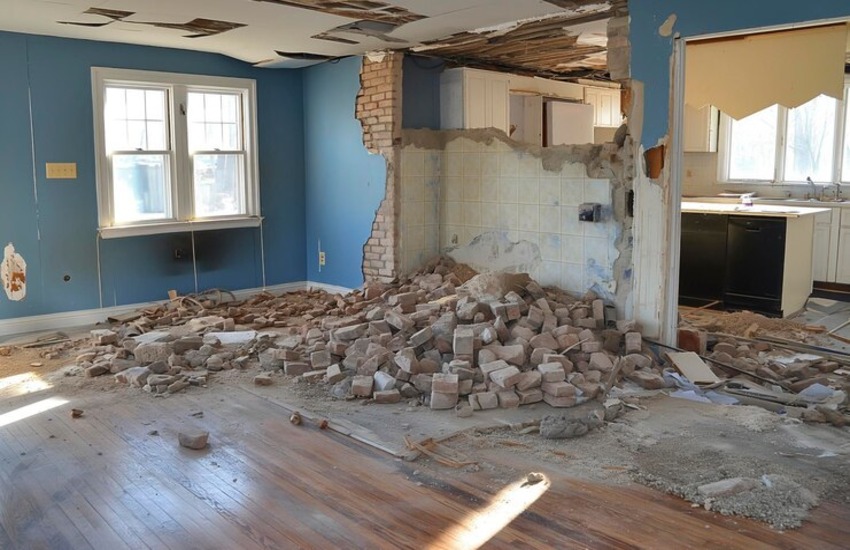Disasters are the enemy of the aesthetics of your house. They strike your home, damaging it with water, fire, storms, or mold. In such a condition, choosing a professional who meets your needs can make the recovery process smooth and stress-free.
However, with so many contractors available, getting confused is very common. Hence, in this guide, we’ve added six essential tips to help you find the right contractor for your project. We also ensured quality work and peace of mind.
6 Important Points to Hire a Contractor for Mitigation and Reconstruction
Verify Licensing and Insurance
First and foremost, make sure the contractor is properly licensed and insured. A license confirms that the contractor meets state and local regulations. Meanwhile, insurance protects you in case of accidents or damage during the project.
Apart from the license, check their liability insurance and workers’ compensation coverage. According to the National Association of Home Builders (NAHB), hiring an uninsured contractor could leave you financially liable for on-site injuries.
Ask for proof of both licenses and insurance to verify their validity with the appropriate authorities. Remember, working with a licensed and insured contractor not only ensures professionalism but also minimizes your risk during the project.
Assess Experience and Expertise
Undoubtedly, not all contractors have the same skill set. While general contractors might excel at new construction, mitigation and reconstruction require specialized knowledge.
Mitigation involves immediate actions to prevent further damage, while reconstruction restores your property to its pre-disaster state. Hence, choose a contractor with proven expertise in both areas.
You can also ask about their experience with your specific type of damage, such as water damage, fire damage, natural disaster, etc. A contractor experienced in these areas will understand the complexities involved and provide solutions tailored to your situation.
Check References and Reviews
A reputable contractor should have a history of satisfied clients. You can check on their previous works to see if they meet your expectations. And while doing so, you can also ask — Did the contractor complete the project on time and within budget? Were they responsive to questions and concerns?
Online reviews are another valuable resource. Customer reviews at Google, and Yelp provide insights into a contractor’s reputation. According to the survey, 87% of consumers read online reviews before choosing a local business.
Remember, consistently positive reviews and high ratings indicate a trustworthy contractor. On the other hand, patterns of negative feedback should raise red flags.
Demand Transparent Communication
Clear communication is essential throughout your project. The contractor should explain their process, provide a detailed estimate, and set realistic timelines. While working, you need to ensure that there’s no miscommunication. It can lead to misunderstandings, delays, or unexpected costs.
Request a written contract that includes:
- A detailed scope of work
- Project timeline
- Cost breakdown
- Materials to be used
- Warranties on labor and materials
Avoid contractors who are hesitant to provide documentation or offer vague agreements. Remember, transparent communication ensures both parties are on the same page, reducing potential conflicts.
Avoid Large Upfront Payments
Always be cautious of contractors who demand large upfront payments. Most states limit the initial deposit to 10-33% of the total project cost. Reputable contractors will structure payments in phases, with installments tied to project milestones.
Large upfront payments can be a warning sign of financial instability. Instead, you can go for a payment in stages, such as after completing mitigation work or finishing a reconstruction phase. This approach protects your investment and motivates the contractor to stay on schedule.
Additionally, always make payments through traceable methods like checks or credit cards with a proper invoice. Besides, you should avoid cash payments, which provide little recourse if issues arise.
Evaluate Their Plan and Materials
A professional contractor should present a comprehensive plan for your project. It should include the steps they’ll take and the materials they’ll use. Hence, before you start the project, ask detailed questions to understand their approach to both mitigation and reconstruction.
For example:
- How will they prevent further damage during mitigation?
- What methods will they use to dry and clean affected areas?
- Which materials will they use for reconstruction, and why?
High-quality materials and skilled craftsmanship are essential for long-lasting results. Make sure the contractor is transparent about the material choices, offering options that suit your budget and preferences. Remember, cutting corners on materials may save money upfront but can lead to costly repairs later.
Conclusion
Mitigation and reconstruction are vital projects. They need professional hands to get good results. And we hope that this guide helps you know how you can choose the right contractor for your house.
However, if you’re living in Sachse, Texas, you can reach us for your home remodeling. At Oak Custom Remodeling, you can rest assured that your home is in expert hands. Our professionals are well experienced with the mitigation and reconstruction process.














